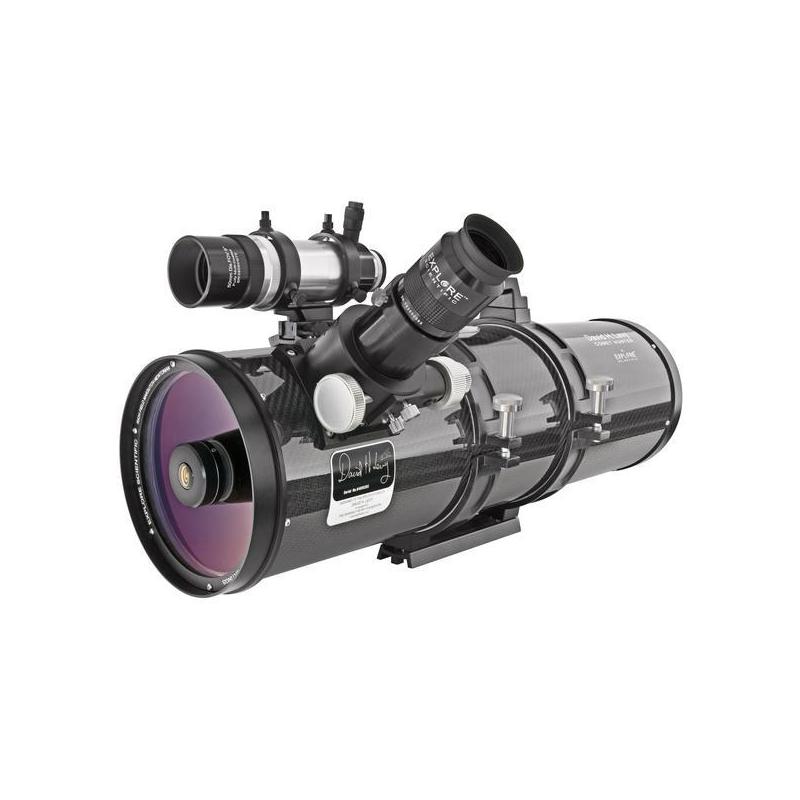Explore Scientific MN-152/740 6" Optical Tube
Highly corrected Maksutov-Newton. Aperture: 152mm. Focal length: 731mm
| Product ID | 71406 |
| Brand | Explore Scientific |
| Warranty | 2 years |
| EAN | 4007922154251 |
| Shipping Weight | 11 kg |
| Optical design | catadioptric |
Highly corrected optic for wide-field observation and astrophotography. Developed in collaboration with the famous "comet hunter" David H. Levy. The Maksutov-Newton system does have some pros and cons respectively to the classical newtonian design. Apart from the higher price the main disadvantage is the higher weight – the thick corrector lens at the front is the cause for this. The main advantage of the Maksutov-Newton compared to the classical newton is the sharpness of the field of view. Classical newtonian telescopes do show a sharp pinpoint star image only at the middle of the field of view – outside the optical axis they have a dominant abberation, the so called coma. This is inherent in the newtonian design, and therefore valid for all newtonian telescopes of all brands and not caused by manufacturing tolerances. Coma distorts the star image – the pinpoint star shows a tail, just like a small comet. This decreases sharpness and contrast considerably. The Maksutov-Newton shows a much sharper star image – for most applications the coma is not visible. This results in a high contrast image all over the field of view – for visual observations and for astrophotography with DSLRs alike. This makes the Maksutov-Newton a ideal all-purpose telescope, that is able to show a sharp field without the need for additional correctors.
Features:
- Highly corrected Maksutov-Newton
- Carbon fiber tube for superior rigidity and low weight
- Thermal focus shift very close to zero due to carbon tube
- Excellent performance without additional corrector for visual and astrophotos up to APS-C
- Handle with camera mounting feature
- Universal 44mm dovetail plate with stainless steel rail (fits Vixen SP/GP; Meade LXD75; Sky-Watcher EQ5; Bresser EXOS I/II)
- Excellent straight through finder scope with illumination unit
- Dust protection caps for front lens and eyepiece holder
The kit includes:
- Telescope
- Tube rings with handle
- 8x50 finder scope
- 25mm eyepiece
- Focuser extension tube
- 44mm universal dovetail plate
- Reducer 2"/1,25"
- Carbon fiber dew shield
- Manual
| Product ID | 71406 |
| Brand | Explore Scientific |
| Warranty | 2 years |
| EAN | 4007922154251 |
| Shipping Weight | 11 kg |
| Optical design | catadioptric |
| Optical scheme | Maksutov-Newtonian |
| Primary mirror diameter (aperture), mm | 152 |
| Secondary mirror diameter, mm | 49 |
| Focal length, mm | 740 |
| Lowest practical power, x | 25 |
| Highest practical power, x | 300 |
| Aperture ratio | f/4.8 |
| Resolution threshold, arcseconds | 0.77 |
| Limiting stellar magnitude | 12.7 |
| Eyepiece barrel diameter, in | 1.25/2 |
| Finderscope | 8x50 |
| Focuser | 2", Crayford, 2-speed (1:10) |
| Optical tube mounting mode | dovetail plate |
| Optical tube material | CFRP (carbon fiber-reinforced plastics) |
| Optical tube weight, kg | 6.7 |
| User level | experienced users, professionals |
| Observed object | planets of the Solar System and deep-sky objects |
and downloads
Convenient diagrams that describe how to install additional accessories on refractors and catadioptric telescopes
Find out how to assemble a telescope on an example of the Levenhuk Skyline 90x900 EQ telescope
This short guide will help you avoid typical mistakes and learn more about telescope and mounting types
The basics of astronomical observations for beginners
In this article we have gathered answers to some of the most frequently asked questions about telescopes
How telescopes work?
You can actually perform observations from your balcony!
All about telescope sizes, types, magnification, and mounts
Learn how to set up and use the telescope properly
Astronomy in light-polluted skies. Find out what you can observe in the city
Read an interesting comprehensive article on telescopes for little astronomers
Celestial objects you can observe with telescopes of different apertures
Colored and vivid images of galaxies, planets and star clusters entrance everyone who is fascinated by boundless space
Find an interesting review on the history of the changes to a refracting telescope
To make the process of choosing a telescope easier, we will tell you about the characteristics of the most popular types of telescopes today
Learn everything you need to know about refractor telescopes to make the right choice

 BG
BG  BY
BY  CY
CY  CZ
CZ  DE
DE  EE
EE  ES
ES  GR
GR  HU
HU  IS
IS  IT
IT  LT
LT  LV
LV  MY
MY  PL
PL  PT
PT  RO
RO  SK
SK  TR
TR  UA
UA  USA
USA 







